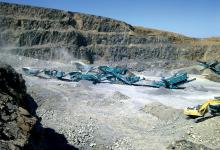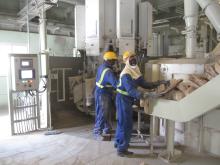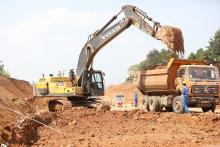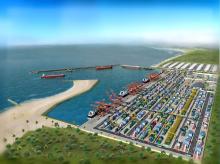
East Africa’s aggregates market is looking very promising, but there are key challenges to overcome before it can be fully cultivated. Shem Oirere reports.
The East African region anticipates a construction boom in 2015 and beyond, according to national development plans unveiled by Kenya, Tanzania, Uganda, Rwanda, Burundi and Ethiopia.
However, these countries face a challenge to supply construction materials to meet the demand of an expanding construction sector, especially aggregates because of an underdeveloped mining industry.
Kenya, the region’s largest economy with a $12.6 billion budget for 2014/15, has allocated US$1.2 billion for its road sector, $247 million for a new railway, and an additional $17 million for airport and port projects.
Furthermore, the country has started the construction of one of the largest infrastructure projects in Africa in partnership with South Sudan and Ethiopia. The $29.24 billion Lamu Port South Sudan Ethiopia Transport (Lapsset) corridor project which entails, among other works, the construction of 32 berths at Manda Bay in Lamu Port, construction of an 880km highway and 1,710km standard gauge railway line, is expected to consume several million tonnes of aggregates in construction works.
Kenya has also recently launched the five-year construction of 10,000km of roads to bitumen standard, raising even higher the anticipated demand for aggregates in the country.
Across Eastern Africa, where analysts say there was combined economic growth of 6.4% last year (up from 6.1% in 2013), numerous infrastructure projects are underway or planned. This has led to predictions that the demand for aggregates, especially for the supply of sand, cement, gravel, stone, and bricks, could spike substantially as projects get implemented.
For example, increasing urbanisation in Eastern Africa has created an acute shortage of housing in cities and towns, with the African Development Bank saying Tanzania has a shortfall of 3 million housing units, while Kenya and Uganda have a shortfall of 2 million and 1.5 million units respectively.
Also, countries in the region have separate plans on how to reduce the combined non-paved road network from the current 249,298km. Slightly more than 8% of the entire classified road network in East Africa is paved.
Eastern Africa has huge unexploited potential of construction materials, and untapped underground resources could run into millions of tonnes.
Many of the sites for the production of sand, gravel, stone and the making of bricks in Eastern Africa are found both near urban areas and deep into the rural interior, where transport infrastructure is a major challenge for the workers and buyers of the mined materials. Across the region, the mining sites are owned by both individuals and governments, where a quarry falls under public land.
The largest mining sites are those producing limestone for East African cement makers especially in Uganda, Kenya and Tanzania.
In Uganda, Hima, Musekura and Dura are the largest limestone quarries operated and mined by Hima Cement, which is 70% owned by French cement giant
Statistics by Uganda’s Ministry of Energy and Mineral Development shows that Musekura quarry has an estimated 543,000tonnes of limestone reserves that could be mined over the next three and half years at the rate of 150,000tonnes/year.
Dura quarry has been divided into three sites (A, B and C) with a combined lease area of 450ha. Currently quarry C is the only one being mined after surveys showed part of quarry B lying within a Ramsar site, and hence could not be mined.
Approximately 520,625m² is actively being mined according to a report by the National Association of Professional Environmentalists late last year.
In neighbouring Kenya huge limestone deposits have attracted a number of cement manufacturers including Africa’s leading cement maker
Dangote Cement, with an estimated market capitalisation of $20 billion, has announced plans to set up a $400 million cement making plant in Kenya’s Kitui County in partnership with the
The Nigerian-based company, which operates terminals in Nigeria and Ghana where it imports and bags cement and has operations in Benin, Ghana, Senegal, South Africa and Zambia, has also acquired a limestone prospecting licence for the Kitui limestone acreage. The entry of Dangote into Kenya’s limestone mining sector is set to trigger stiff completion for the cement-making raw material.
It is in this same Kitui County that Kenya’s largest cement manufacturer, Athi River Mining (ARM) has planned to construct a $285 million cement plant to utilise the huge capital deposits.
Earlier, Indian conglomerate Sanghi Group’s
Previous studies by government agency Kerio Valley Development Authority and a Canadian firm M/s Lavalin International estimated the limestone deposits in West Pokot at more than 15 million tonnes of moderate magnesium limestone which analysts say could translate into 300,000tonnes/year of cement.
A report on natural resources in the county by West Pokot county government says at the Ortum site, which is the core of Cemtech’s investment, there is an estimated 5.9 million tonnes of limestone, ‘which would be blended with low grade reserve of between 12 and 17 million tonnes of the same raw materials at Chepchoi’.
‘The limestone deposits would sustain a cement crushing plant for more than 50 years, which means a cement factory would be viable,’ says the report released late last year.
Another cement maker in Kenya,
The company announced last year it has received $70 million from the World Bank’s lending arm
An Environmental Impact Assessment (EIA) report on the company’s planned Kajiado clinker project says the ‘limestone deposits were the major determinates when choosing the project site.’
The limestone, the report says, will extract from an open mine, a popular limestone mining technique across East Africa.
‘Blasting will be required in hard limestone, but the shale and sand can be removed by a mechanical excavator,’ the report says, adding that ‘the volumes of limestone and shale to be mined to produce 7,000 tonnes of clinker will be 10,769 tonnes.’
The extent of the quarry area to be operated by the cement firm will be determined by the maximum depth, which will be gauged from the results of the drilling exploration, according to the report.
‘Preliminary results show that the area has limestone, but in sections. What this means is that after the mining exercise is over, say in 100 years, the area won’t have been turned into one big depression/lake,’ says the report.
The growth in limestone mining investments is to support the anticipated rise in demand for cement to about 20 million tonnes over the next few years.
‘This demand for cement is the real attraction for East Africa,’ says Athi River Mining commercial director Bipin Bhatia.
He predicts that production of cement in Kenya could rise to 18.55 million tonnes – from the current 13.3 million, while clinker capacity in the country could increase by 4.65 million tonnes to 7.83 million tonnes.
In Tanzania, Bhatia predicts an increase in cement capacity to 7.75 million tonnes from 4.9 million tonnes, with another increase projected for clinker to 6.32 million tonnes from 1.87 million tonnes.
Uganda and Rwanda anticipate cement capacity rising 3.6 million tonnes and 0.55 million tonnes up from 2.4 million tonnes and 0.5 million tonnes respectively over the next three years.
Other players in East Africa’s aggregate industry include Rwanda’s Rusororo Aggregate Ltd, the country’s first large-scale stone extraction company. It owns three quarry sites with estimated stone deposits of 3.5 million m³.
The Rwandan aggregates market, like that in Kenya and Uganda, is poised to grow fuelled by a strong construction project portfolio particularly housing.
“Rwanda’s housing sub-sector in particular is unable to cope with ever increasing demand that is set at more than 20,000 units annually and still growing,” said a previous statement by the country’s mining ministry.
However, the ministry says lack of affordable and quality construction materials is one of the “structural weaknesses that the sector players face in meeting the rising demand for housing units.”
The government hopes to use the shortage as an opportunity to invest more in exploiting the “high potential in construction materials and specifically quarries which had less people investing in it while most of the companies in the mining sector are much more focused to mineral resources such as Gold, Cassiterite and Coltan.”
Rwanda has supported the establishment of the East African Granite Industries for two years with an initial investment of $15 million targeting quarrying and granite processing, the first such state-backed investment in Eastern Africa.
“The investment in the field was due to the high demand for building and construction materials in the country and regionally,” a Rwandan mining ministry statement had said previously.
Multiplex Ltd of Uganda is another quarry operator with substantial interest in the landlocked country’s aggregates market. It operates the Wankoba stone quarry in Mukono district with the company saying on its website that the 200ha quarry area has “a strong rock that produces good aggregates.” Multiplex has installed a mobile crusher with capacity to process the rocks right from the primary phase to secondary and finally tertiary stage.
“The mobile crusher has been built to match any modern stone quarry standard with capacity to crush over 150tonnes of aggregate/hour and produce 12 to 15 tonnes/truck,” the company says.
A few companies are involved in the supply of equipment and machinery to meet the demand for this nascent market. South Africa-based AEL Mining Services, which has set up base in Dar es Salaam, Tanzania, is one of the suppliers eyeing the anticipated growth of the region’s aggregates market.
The company specialises in the making and supply of a full range of bulk explosives and cartridge explosives for use in quarries, opencast mining, construction and mining industries.
AEL, which has a bulk explosives manufacturing plant at Geita in Tanzania and Legadembi in Ethiopia, says it has targeted the stone quarrying clients, limestone miners and tunnelling operations especially for hydropower generation. Almanaiah Heavy Equipment is another company that is making inroads in East Africa’s construction industry through supply of used earth-moving equipment including brands such as
With East Africa’s construction industry beginning to realise increased investment from both governments and private companies, harnessing of the region’s aggregates market has just begun.









